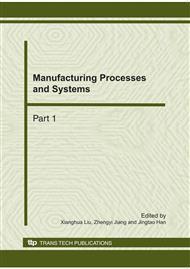p.753
p.758
p.763
p.769
p.774
p.778
p.783
p.788
p.794
Fatigue Failure of Silicon Nitride Ceramic Balls
Abstract:
Silicon nitride ceramic ball surface is examined after failure with scanning electron microscopy. The profile of the fatigue spalling takes the shape of an ellipse. The failure cause, fatigue phenomenon and mechanics are analyzed. The research shows that subsurface cracks play a dominant role in the formation of spalling failure. These cracks originated from volume defects of the material, and propagate, to form fatigue spalls under the action of principal tensile stresses. The contours of equal tensile stress of Oxy plane underneath surface are elliptical. Subsurface cracks are shape of ellipses and spall is also of the elliptic shape. The principal tensile stress increases with increasing contact load, causing spall formation and reduction of rolling contact life.
Info:
Periodical:
Pages:
774-777
Citation:
Online since:
October 2010
Authors:
Keywords:
Price:
Сopyright:
© 2011 Trans Tech Publications Ltd. All Rights Reserved
Share:
Citation:


